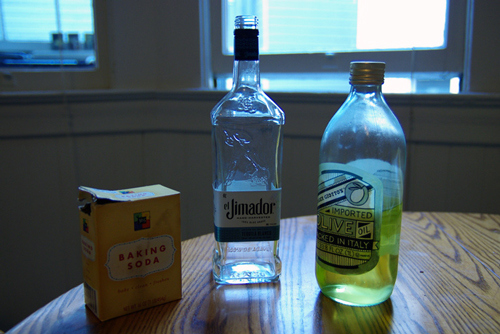How to Rebottle Roadside Mezcal
Contributed by on Aug 27, 2014
Four readers love this post.

As any mezcal fan who’s visited Oaxaca knows, some of the region’s finest mezcals are found in roadside palenques, in the mountains and pueblos a few hours outside of Oaxaca City. However, despite how finely they are crafted, their mezcaleros tend to not treat the bottling process with as much reverence. More often than not, you’ll end up taking your wonderful spirits home in a plastic one-liter Coke bottle, filled on the spot from a five- or 10-gallon can with a funnel—not the most pristine bottling conditions.
On a recent trip, my guide out into the hills was kind enough to rebottle some of my new purchases in exportable-looking sealed glass, for a small fee. Which was great, but I didn’t love the look of those bottles, and there was a fair bit of particulate floating around in them—fine fibers and the like, picked up from that outdoor bottling effort.
I decided to do a bit of simple filtering and rebottling, and here’s how:
First, I grabbed an empty bottle that I liked—in this case, an El Jimador castaway. El Jimador’s got an aluminum cap and collar, so I cut away the collar (carefully) with a pair of wire cutters (it’s pretty thin—no need for anything heavy duty here).
Some bottles’ labels won’t present too much of a problem once you soak them for a minute or two in hot water. However, others (like Hendrick’s Gin, I’ve noticed) need something a little more high-powered. The solution? Olive oil and baking soda.
You can either make a paste of the two, or just, you know, pour on some oil and pour on some soda and give it a scrub with a scouring sponge. The oil dissolves the label’s glue, and the baking soda provides just the right amount of abrasion to cleanly remove the stickiness.
Give it a soapy wash and rinse, and you’re ready to go.
With your bottle prepped and drying upside down (set it in a pint glass to get all the drops out, and to keep it from tipping), grab a basic coffee filter, filter cone, and another pint glass. Soak the filter under the tap for a few seconds to get rid of its papery residue. Then make sure to wring it out gently (be firm enough to get all the water out, but gentle enough not to tear it, obviously). Place it in the filter cone, atop the pint glass.
Now, pour your mezcal through the filter, filling the pint glass, but not so full that you can’t safely repour its contents into your new bottle.
Lastly, set that funnel atop your dry bottle, pour in your mezcal, and cap it however you like. It’s worth doing this over something like a baking sheet, in case you spill. No one wants to lose any mezcal in the process, and if you use a baking sheet, you can collect any errant drops for bottling. I chose to keep the original masking-tape label to preserve a bit of the bottled-onsite vibe.










